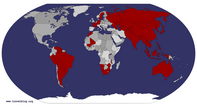Advertisement
Published: April 21st 2007

 Quite frankly....
Quite frankly....
...that was utterly dreadful With 2 nights sleeping at Caracas airport behind me I was Peru-bound at long, exhaustingly last. I arrived in Lima at 5am, so decided there was no point checking into a hostal at that time and got straight on it with a whistlestop tour of Lima instead. I ended up in the plusher suburb of Miraflores on the coast, which is a surfers and gamblers paradise. I'm no surfer, so lost a quick few Soles on Blackjack and moved on the next morning.
The body of Peru is split into 3 distinct geographies - the very arid desert coastal belt; the Andean spine; and the Amazonian right shoulder. Originally I had planned to enter Peru via the Amazon, but fate and friends conspired and hence I flew directly to Lima.
As always, I had a quick flick through the Lonely Planet pages on the flight, who's well-researched insight stated;
"So you've seen pictures of the cloud-topping Inca city of Machu Picchu. And the immense desert designs stretching for miles around Nasca. Well, these are not even half of what Peru has to offer..."
Immediately I got excited about what the other 3 things might be. Truth be told, Peru has
a vast array to keep an ADD traveller like myself occupied. I think I'm going to take up discrediting Lonely Planet as a new pursuit - along with their misplaced disapproval of Guyana and their inability to foresee the inflationary prices in Venezuela since publication.
From Lima, I travelled down the coast to the village of Huacachina, set on an oasis lake in the middle of dozens of massive sand-dunes. This has become a popular stop off point for up-and-coming sand-boarders... like me. I wouldn't say I was a natural, but I stayed upright longer that I rode bareback on a bull, before wiping out and tasting sand.
I stayed the night in the nearby city of Ica, the highlight of which is the museum housing mummified mummies, deformed heads, and skulls that have undergone trabanation - the act of cutting out a portion of the skull, standard medical practice in pre-Inca times. That night I ate in the highly recommended restuarant, El Otro Peñoncito, where I was the only client and so the manager came and sat with me. American Pop Idol was on the TV - Simon Cowell is even more amusing slating Americans who have never been
fed anything other than praise throughtout their sugarplum lives. As I chatted with the manager, he asked me what I did for a living. A perfect opportunity to pull out the "I'm a travel-writer" card. Shortly after, I was enjoying a free dessert and extra beer. I felt a bit cheeky, so left a half-generous tip.
The next stop was Nasca, whose claim to fame is the nearby Nasca Lines, the massive stone markings laid out across the Nasca desert. The only way to view these is from the air, which is why they were not even rediscovered until 1939, when some German flew over and spotted them. In fact, the early part of last century proved highly significant in putting Peru on the map. The lost Inca city of Machu Picchu was only re-found in 1911, and a few decades later Paddington Bear set sail from "deepest, darkest Peru" for his pioneering quest to London. The rest is history.
I forked out to take the 30 minute flight over the "must see" Nasca Lines. There was a slight delay though. I had paid a little extra to go in one of the smaller planes, which seats 4 people including
the pilot. The other 2 passengers arrived at the airfield. They were 2 very large ladies on vacation from Wisconsin. I'm talking VERY large - Think Viz. One was 320 pounds and the other was a slenderer 290 pounds. I know this because we had to put our names, passport numbers and weight in the manifest. The guide had to diplomatically inform them the plane couldn't carry all 4 of us, so instead of splitting them up I got to fly with just the pilot.
We flew above the lines, zipping between the more notorious designs. I didn't want to offend anyone, but my first thoughts were that I could have drawn a more realistic dog or monkey, and I can't draw. The parrot was particularly unparrotlike - more spannerlike (see picture).
There are several theories behind the origin and significance of the Nasca Lines - that it is an astronomical map; that it shows the position of ground water; or even that they are a message to aliens. None of the theories can fully explain their existence though. Maybe they are just pictures in the desert.
Between Nasca and Cusco is the city of Arequipa - yet another quaint
colonial city surrounded by volcanoes. Been there, done that. I stayed long enough to visit the Museum Santuarios Andinos, which houses 'Juanita, the Ice Princess'. According to the guide, she was a young Inca girl, whose sacrificial body had been perfectly preserved in the ice for 500 years, only uncovered during an avalanche a few years ago. I have attached a picture, so you can judge for yourself whether the preservation has been entirely 'perfect'.
After so long in transit from plane to bus to plane to bus to bus, I decided I would treat myself to some outdoor adventure time, so took a short diversion to the Cañon del Colca in the Andes - at 6 hours, this was the same kind of short diversion that someone might take from London to Edinburgh. Cañon del Colca, along with the neighbouring Cañon del Cotahuasi, are the deepest canyons in the world, at about 3200m. I stayed the night at Cabanaconde on top of the southern ridge of the canyon and decided I would venture the next morning to the ravine at the bottom of the canyon and stay the night in a small village alongside the river. Again, I saw

 Juanita
Juanita
The perfectly preserved 10 yr old ice princess?no problem in taking this on alone, as there was only really one direction to go - down. It took Pavlov less time to condition drolling dogs than it is taking me to learn that hiking alone in the Andes is not altogether a sensible pastime. I found no problem in navigating my way down to the Rio Colca, snaking its way along the canyon floor. What I had failed to consider in my suck-it-and-see approach was how I was going to cross it, as I needed to be on the north ridge. I was followed the entire trek by a puppy from the hostel in Cabanaconde. It would not leave me alone, no matter how many times I shouted, kicked it or threw stones at it. The trek down was spectacular. Giant Andean condors soaring on the thermals above, and sometimes below. The region is also home to all 4 American camelids: the llama, alpaca, vicuña and guanaco. I saw a handful of these, but I couldn't be sure which species they were as my knowledge of these is, at best, woolly.
I found the village I was seeking, stayed the night, hiked back up the canyon next morning,
grabbed my belongings from the hostel in Cabanconde and jumped on a bus to Cusco. A few hours into the journey I noticed my iPod was no longer with the rest of my belongings, suggesting it had made its way out of my backpack and into the hands of the hostel security guard whilst I was down the canyon. Not too much I could do about it now, so I was resigned to no music or podcasts for the next 3 months. It made me realise that one thing you miss out on when travelling is new music (arguably my finger is not on the pulse when back home either). Another is local C-list UK celebrity deaths. If someone of global significance dies, like the Pope, Queen Mother or Anna-Nicole Smith, I'll hear of it, but if Rolf Harris wobbled his last wobbleboard, I doubt CNN would carry the story. As for other celebrity gossip, I have no idea what's going on in the world of Heat magazine right now. But for every void, something else new comes along. In my case, vest-tops and Gatorade, neither of which played a role in my life previously. Gatorade is a thirst-quenching energy
drink. It was designed by a bunch of doctors at the research lab at Florida Uni, who were charged with coming up with a half-time boost for the college football team, the Florida Gators - hence the name. Unlike Red Bull, Coke, etc, it is not caffeine based, but contains electrolytes, which I'm sure are what I used to end up with in A-level chemistry when sending an electric charge through liquids. Either way, its great for hydration and has kept me moving.
And so to Cusco to get myself on the trail to Machu Picchu.
Here's one to leave you with. When I was crossing the river-border between Guyana and Brazil, there was a road bridge being built. The thing is, (ex-British) Guyana drives on the left and Brazil, along with the rest of South America, drives on the right. I have it on good authority that this bridge will be built with a scalextric-esque crossover of the lanes in the middle, so that you automatically end up on the correct side. I tried to think of 2 other land bordering countries that may face the same problem, but none immediately come to mind. Anyone?
Advertisement
Tot: 0.063s; Tpl: 0.012s; cc: 13; qc: 33; dbt: 0.0295s; 1; m:domysql w:travelblog (10.17.0.13); sld: 1;
; mem: 1.1mb












Your King
non-member comment
I am a fountain of knowledge
How about India and China or Namibia and Angola. I am sure there are more too!